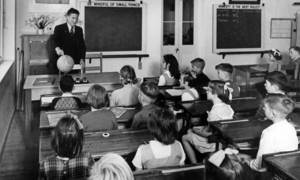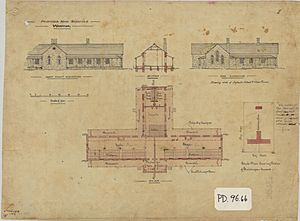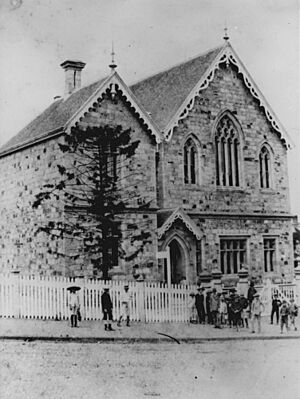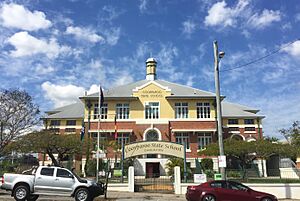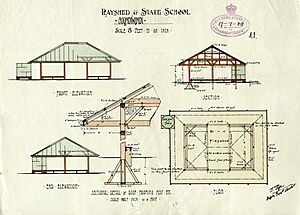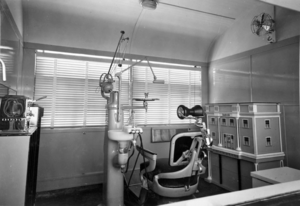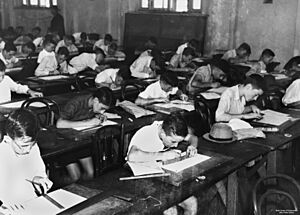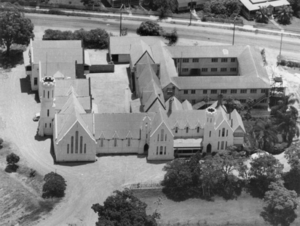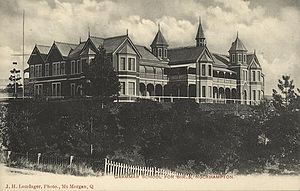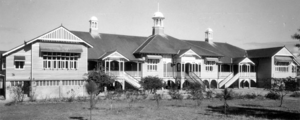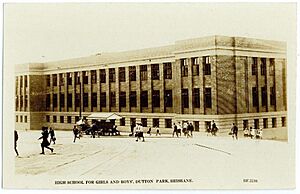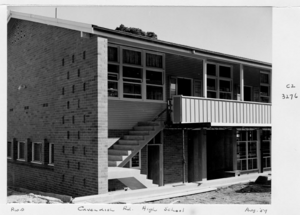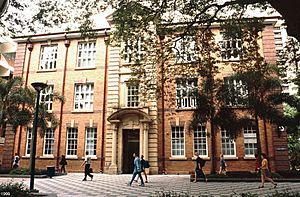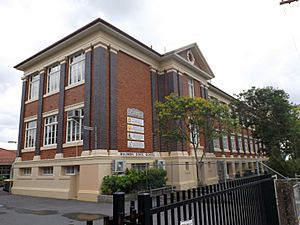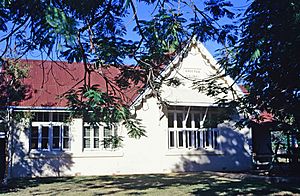History of state education in Queensland facts for kids
The history of state education in Queensland tells the story of how public schools in Queensland, Australia, came to be. It all started when Queensland was part of New South Wales, back in the days of the Moreton Bay penal settlement. After Queensland became its own colony in 1859, its government took charge of setting up schools for everyone.
Contents
Primary Education: Learning the Basics
Early Schools in New South Wales (Before 1859)
The very first primary school in Brisbane (then called the Moreton Bay penal settlement) opened in 1826. It was run by Esther Roberts, a soldier's wife. Even though the New South Wales government paid her, the Anglican Church managed the school. This was because people believed churches should run schools back then. The school closed in 1842 when the penal settlement shut down.
In the early days, most schools were small and didn't last long. Many were private schools held in people's homes. They charged high fees, and the quality of teaching wasn't always great. In 1845, the first Roman Catholic school opened, starting a trend of small church schools. However, many children in the Moreton Bay area didn't get any formal education at all.
To fix this, the Governor of New South Wales, Charles Augustus FitzRoy, created the Board of National Education in 1848. Their job was to set up government schools, like the "National Schools" in Ireland. These schools taught regular subjects and non-religious scripture lessons. Church leaders could also visit to give religious lessons if parents wanted. The National Board helped build schools if parents paid a third of the costs and promised at least 30 students would attend. Parents also paid school fees, which helped pay the teachers. The lessons included reading, writing, grammar, geography, and basic science.
Four National schools were set up in what would become Queensland: Warwick (1850), Drayton (1851), and Brisbane Boys and Brisbane Girls (both 1860).
Queensland Takes Over (After 1859)
Queensland became a separate colony from New South Wales on 10 December 1859. The new Queensland Parliament then had to create its own education system. They formed the Board of General Education, which took over the four National schools. This Board could also set up new primary schools. They also paid teachers in church-run schools, but they closely watched these schools to make sure they met certain standards.
The schools taught the same subjects as before. However, religious instruction had to happen before or after school, which made it less popular. In 1862, a new building called the Normal School was built in Brisbane.
Normal Schools were important because they were training centers for future teachers. Young people, sometimes as young as 14, became "pupil-teachers." They taught classes during the day and received their own training before and after school. This was a cheap way to get teachers, but it was tough on them!
In 1869, the Board started "provisional schools." These were a way to provide basic education in areas with fewer children (as few as 15, later 12). Local people had to provide a building, which was often very basic. Teachers' salaries were low, and their training wasn't always good. Provisional schools were meant to be temporary, eventually becoming full state schools. But often, they closed down as people moved away.
A big change happened in 1870: school fees for National schools were stopped. Fees had been irregular and caused students to miss school.
By the 1870s, Queensland was doing well, thanks to gold rushes. This led to the State Education Act of 1875, which brought in important changes:
- Primary education for children aged 6 to 12 became compulsory (though it wasn't fully enforced until 1900).
- Education became secular, meaning it was controlled by the Queensland Government, not churches. This meant the government stopped helping church schools, which upset some people.
- Primary education became free.
- A new government department, the Department of Public Instruction, was created to manage everything.
The Department of Public Instruction (Late 1800s - Mid 1900s)
As more people settled in Queensland, the number of schools grew a lot, from 231 in 1875 to 911 in 1900. This put a strain on the education budget and led to teacher shortages and many poorly built provisional schools. However, by 1900, most Queensland children could read and write, which was a great achievement!
The "pupil-teacher" system continued to be the main way to train teachers until 1914, when a proper teacher training college opened in Brisbane. In 1909, a big change happened: the minimum number of students needed for a state school was lowered from 30 to 12. This meant many provisional schools became state schools, improving their standards.
The main subjects taught were the "three Rs": Reading, Writing, and Arithmetic. Other subjects like geography, needlework, and history were also included. At first, subjects were chosen to "sharpen" students' minds, like memory and reasoning.
By the 1890s, people started thinking more about how useful subjects were for everyday life. Subjects like agriculture and home economics were introduced. The idea of "learning by doing" became popular. The focus shifted from the teacher to the student.
This led to more emphasis on vocational subjects (skills for jobs) like manual training and agriculture. For example, in 1917, "Rural Schools" were introduced. Boys learned farm management and manual skills, while girls learned home management and needlework. These schools were important until the 1960s.
Distance was always a challenge in Queensland. To help, the Department started an "itinerant teacher scheme" from 1901 to 1932. These teachers traveled to isolated areas to bring books and lessons to children of settlers and farm workers. But they could only visit families a few times a year. Later, the Primary Correspondence School (founded in 1922) took over, sending lessons by mail. This was especially important during World War II when many schools closed. Special railway cars were also fitted out as traveling domestic science and manual training classrooms, and even dental clinics!
After 1907, the Department also started focusing on students' health. They tried to fight eye infections common in western Queensland. In 1911, a Medical Branch was created with traveling doctors, dentists, and eye specialists.
A big influence during this time was the Scholarship examination. This test was first designed to help a few smart students get into secondary school. Over time, more students were able to get scholarships. But by the 1950s, many educators felt this exam was holding back new ideas in primary education.
The Great Depression (1930s) and World War II (1939-1945) caused problems for schools. Building programs slowed down, teachers' salaries were cut, and there were staff shortages. After the war, the "baby boom" meant even more children, leading to crowded classrooms and ongoing staff shortages in the 1950s.
The Department of Education (Mid 1900s - Present)
Until 1963, primary school ended with the Scholarship examination, which decided if students could go to secondary school. Many people criticized this exam because it limited what teachers could teach and what students could learn. It also limited opportunities for many children to get a secondary education. By the late 1950s, the government decided to make secondary education available to everyone, so the Scholarship exam was no longer needed.
The Scholarship exam was finally abolished in 1963. This, along with the State Education Act 1964, started a new era for primary education. School subjects were completely updated, with new lessons for maths, science, language, social studies, art, health, physical education, and music.
These new programs gave teachers more freedom. Instead of strict rules, teachers had general goals and basic structures, allowing them to plan lessons that better suited their students.
To support this new freedom, more help was given to teachers. Training programs were expanded, and "teachers centers" were set up. New specialist teachers were introduced, like teacher-librarians and resource teachers. Teacher aides were also hired to help with non-teaching duties.
A major change after 1973 was more funding from the Australian Government. This helped improve school libraries and support disadvantaged students, including Aboriginal children, migrants, and those in isolated areas. This helped Queensland achieve its goal of equal education for all.
In the 1970s, the community also became more interested in education. This led to debates about what schools should teach, like the importance of the "three Rs" and whether to include religious education.
New teaching methods also led to new school buildings. In 1970, Petrie Terrace State School opened with modern designs, including open teaching spaces and soundproofing.
21st Century Primary Education
In 2007, a "Prep" (preparatory) year was introduced for children before Year 1. It was optional at first but became compulsory in 2017. This also meant the entry age for Year 1 was raised by six months.
In 2015, Year 7 moved from primary schools to secondary schools. These changes were made to match other Australian states and to help introduce the Australian Curriculum in 2014. This national curriculum aims to provide a more consistent education across Australia, making it easier for children who move between states.
Secondary Education: Beyond the Basics
Grammar Schools (Early Secondary Education)
In 1860, Queensland's first Parliament passed the Grammar Schools Act. This law allowed towns to set up grammar schools if they could raise £1000 locally, and the government would give them double that amount. Each school had its own board to run it. The first grammar school, Ipswich Grammar School, opened in 1863. By 1892, ten grammar schools had opened, including Rockhampton Girls Grammar School.
Queensland grammar schools were like traditional English schools, focusing on subjects like Latin and Greek. They charged fees, so mostly children from wealthy families attended. These schools were for a small, elite group, as most people didn't think advanced education was needed for everyone back then.
Scholarships were available for grammar schools from 1864, but only a few were given out at first. In 1883, the first formal Scholarship examination was held. By 1914, all students who scored 50% or more on the exam could get a scholarship to any approved secondary school, including the new state high schools.
In 1891, a special committee suggested that the government should control secondary schools more directly, as it would be cheaper and just as good. They thought grammar schools could continue, but there should also be state secondary schools.
At first, the Department of Public Instruction didn't want to expand secondary education. They felt they had enough to do with primary education. They also worried that Queensland's economy couldn't handle too many highly educated people.
Despite these doubts, the Education Act of 1875 was changed in 1897 to allow more subjects to be taught in the highest primary school class, including literature, science, and algebra. This was the start of state secondary education in Queensland.
Technical colleges also started offering secondary classes in the evenings. By 1898, Brisbane Central Technical College offered a full secondary curriculum during the day. In 1910, the Department of Public Instruction opened separate day schools within the technical colleges, which prepared students for university entrance exams.
State High Schools (Education for All)
The big effort to bring secondary education to all Queensland children began in 1912. The Queensland Government decided to open free high schools in towns where at least 25 qualified students were likely to attend, and where there wasn't already a government-funded secondary school. State high schools opened in six towns in 1912: Charters Towers, Gympie, Mount Morgan, Warwick, Bundaberg, and Mackay. Secondary classes were also added to primary schools in other towns. These schools offered general, business, and home economics courses.
Over the next 12 years, more secondary departments and separate high schools opened across Queensland. Brisbane State High School, a very well-known school today, was formed in 1921 by combining high school classes from different locations.
By 1924, there were 22 state secondary schools in Queensland. In 1925, the technical, business, and home economics sections of the Brisbane Central Technical College became separate high schools.
From 1925 to the late 1930s, secondary education didn't expand much, mainly because of the Great Depression. Ayr State High School (opened 1937) was one of the few new high schools. In 1936, the Maryborough Grammar Schools were taken over by the government and merged into Maryborough State High School.
After 1928, "intermediate schools" were created to link primary and high schools. These schools were for 12-year-olds and offered a two-year course with a focus on science, manual training, and home economics. However, this idea didn't work very well because it was expensive and hard to organize separate schools for just two years.
The first suburban state high schools in Brisbane to offer a wide range of subjects opened at Wynnum in 1942 and Holland Park (Cavendish Road State High School) in 1952. Rural high schools always offered many subjects because their towns were smaller and couldn't have separate specialized schools.
By 1957, there were 37 state high schools and 34 secondary departments. After 1957, secondary education expanded greatly. More scholarships were given, many new schools opened, and transport was provided for isolated students. By 1980, the number of state secondary schools had almost tripled!
This growth was due to better economic times and big changes in society. More children were staying in school, and there was a greater need for skilled workers in science and technology. People also moved from farm and factory jobs to office and professional jobs, which needed more education.
By 1960, almost 80% of 14-year-olds were staying in school voluntarily. The Watkin Committee in 1961 suggested raising the school leaving age to 15 and changing secondary school subjects. These ideas were put into action with the Education Act of 1964. This Act created new groups to manage secondary school subjects and exams. They constantly reviewed the subjects to suit the wider range of students now attending high school.
To help students who weren't going to university, simpler courses were introduced in 1965. In 1969, the Radford Committee suggested replacing public exams with a system where schools assessed students themselves.
The Radford Committee's ideas became law in 1970. This meant the Junior and Senior public exams, which had been around since 1910, were held for the last time in 1970 and 1972. The Scholarship exam also ended in 1962. By 1973, no Queensland student had to sit for a public exam! This gave teachers much more freedom in what and how they taught.
A new Board of Secondary School Studies was set up in 1971 to put these changes into action. They created many new subject outlines (syllabuses) between 1971 and 1978. Some schools even created their own subjects.
The new system meant more work for teachers in planning lessons and assessing students. To help, the Department provided more support services, like teacher-librarians, special education teachers, and teacher aides.
Secondary school buildings also changed. In 1973, a new design was approved, creating schools with different areas for different subjects (like a "faculty-based campus"). Craigslea State High School, opened in 1975, was the first school built with this new design.
21st Century Secondary Education
In 2015, Year 7 moved from primary schools to secondary schools. This change, like in primary education, was to align Queensland with other states and support the national Australian Curriculum, making education more consistent across the country.
Between 2007 and 2009, three special academies were opened for high-achieving students in Years 10-12. Students have to compete to get in. Each academy focuses on a specific area and is located near a university that specializes in that area:
- The Queensland Academy for Creative Industries (2008) is near Queensland University of Technology.
- The Queensland Academy for Science, Mathematics and Technology (2008) is near the University of Queensland.
- The Queensland Academy for Health Sciences (2009) is near Griffith University on the Gold Coast.
Technical Education: Learning Trades and Skills
19th Century Technical Training
In the 1860s and 1870s, if you wanted education beyond primary school, you usually went to a grammar school, which was expensive. But some people wanted more practical education to help them get better jobs. In 1872, Charles Lilley suggested that the North Brisbane School of Arts and Sciences should teach young mechanics and tradesmen useful skills. He believed this would help industries grow and improve people's careers.
Technical classes started in 1881, teaching mechanical art and drawing. Students included schoolboys and men studying architecture, carpentry, and engineering. In 1882, the Brisbane Technical College officially began. It was controlled by a sub-committee of the North Brisbane School of Arts and received money from the Queensland Parliament.
By 1889, the College's activities became separate from the School of Arts. David Rose McConnel organized the lessons better. In 1892, the government started giving money to colleges based on how much they earned from student fees. This meant classes like typing and shorthand, which had many students, were more profitable. Science classes, with fewer students, were harder to keep going. The Brisbane Technical College Incorporation Act of 1898 set up a council to control the College.
Outside Brisbane, technical classes were often held with local Schools of Arts. Sometimes, the money given by the government wasn't used properly. Students often chose subjects without a clear career goal. The first technical college to prepare students for a specific job was the Charters Towers School of Mines, which opened in 1901.
By the end of the 1800s, the government wanted to improve technical education in Queensland. They saw how well Germany was doing in industry and trade, partly because of its good technical schools. They wanted to make Queensland's technical education more efficient.
20th Century Technical Training
In 1902, a Board of Technical Education was created to advise the government.
In 1905, the Board was abolished, and a separate part of the Department of Public Instruction took over, giving the government more control. R.M. Riddell was put in charge to develop and supervise technical education. After 1905, colleges became more uniform in their subjects and exams. The Technical Instruction Act of 1908 combined the three Brisbane technical colleges into the Central Technical College, directly controlled by the state. Later, country colleges were also transferred to the Department of Public Instruction.
Warwick Technology College opened in 1906. It became very popular, and a new, larger building was needed. In 1914, the foundation stone for the new Warwick Technical College and High School was laid.
In 1914, the Brisbane Central Technical College moved into new buildings next to the University of Queensland. Its engineering diploma courses were linked with the university's engineering faculty.
After World War I, technical colleges offered training courses for soldiers returning from the war. In 1924, a big step was taken: people who earned certain diplomas from technical colleges could use special "letters" after their names, showing their qualifications were officially recognized.
During the Great Depression in the 1930s, many people lost their jobs. The government hoped that teaching trade skills to the unemployed would help. Unemployed young people were encouraged to attend free training at technical colleges.
When World War II started in 1939, the Technical Education Branch trained thousands of skilled workers for factories making weapons and aircraft, and for technical jobs in the military. After the war, they provided training for returning soldiers again. The post-war period was tough because equipment was old and needed replacing, but costs were rising.
The growth of industries after the war created a huge demand for trained workers. To meet this, technical education was reorganized in the 1960s. Many colleges became "tertiary level" (higher education), and new ones were created. The Australian Government provided money for this. The Education Act of 1964 created a Technical Education Advisory Council to guide future development.
As a result, technical education split into two paths in the late 1960s and 1970s. Tertiary-level institutes of technology were set up in Brisbane (1965), Toowoomba, and Rockhampton (1967). These became independent in 1971. Also, new specialist technical colleges were built around Brisbane, each focusing on specific trades. Many country colleges also moved into new buildings, separate from high schools.
The Rural Training Schools Act of 1965 created schools for specific industries, like the Longreach school (1967) for the wool industry, Emerald (1971) for beef, and Dalby (1979) for grain.
In 1974, a report suggested that technical and adult education needed to be updated and expanded to meet new needs in society. More money was given to this area, and in January 1977, TAFE (Technical and Further Education) was officially created.
New TAFE colleges opened, and existing ones improved. They offered many more courses, especially pre-vocational courses and those to help the community. TAFE colleges aimed to meet the needs of their local communities.
Heritage Listings
Many state education buildings in Queensland are considered important historical sites and are "heritage-listed." Here are some of them:
See also
- Education in Australia
- Queensland State Schools
- List of schools in Queensland


